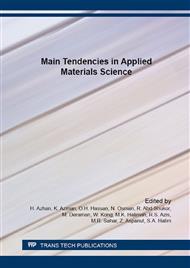p.690
p.697
p.702
p.706
p.712
p.719
p.726
p.734
p.740
Friedel-Crafts Acylation of Anisole over Heteropoly Acid Supported on Porous Montmorillonite
Abstract:
Porous montmorillonite (PMMT) was derived from natural montmorillonite (MMT) through functionalization using 3-aminopropyltrimethoxysilane (APTMS) and intercalation with cationic potato starch as the template. Phosphotungstic acid (HPW) supported on PMMT was synthesized by wet impregnation method. The resulting PMMT showed remarkable increase in surface area from the low value of 191 m2g‒1 for parent MMT to the high value of 930 m2g‒1 for PMMT. Acidity studies by pyridine adsorption followed by FTIR spectroscopy showed that both MMT and PMMT possessed strong Lewis acid sites. In contrast, the surface acidity of HPW incorporated into PMMT was shown to be significantly enhanced by forming mainly Brönsted acid sites. The catalytic activity of these materials was evaluated in the Friedel-Crafts acylation of anisole with propionic anhydride. The PMMT/30HPW catalyst which possesses the highest number of Brönsted acid sites showed excellent catalytic activity giving selectivity as high as 95% toward the main product, p-methoxypropiophenone.
Info:
Periodical:
Pages:
712-716
Citation:
Online since:
March 2016
Authors:
Price:
Сopyright:
© 2016 Trans Tech Publications Ltd. All Rights Reserved
Share:
Citation:


